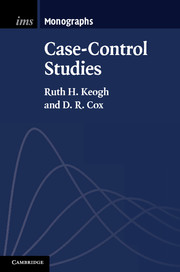Book contents
- Frontmatter
- Contents
- Preface
- Preamble
- Notes
- 1 Introduction to case-control studies
- 2 The simplest situation
- 3 Matched case-control studies
- 4 A general formulation
- 5 Case-control studies with more than two outcomes
- 6 Special sampling designs
- 7 Nested case-control studies
- 8 Case-subcohort studies
- 9 Misclassification and measurement error
- 10 Synthesis of studies
- Appendix: A theoretical diversion
- References
- Index
5 - Case-control studies with more than two outcomes
Published online by Cambridge University Press: 05 April 2014
- Frontmatter
- Contents
- Preface
- Preamble
- Notes
- 1 Introduction to case-control studies
- 2 The simplest situation
- 3 Matched case-control studies
- 4 A general formulation
- 5 Case-control studies with more than two outcomes
- 6 Special sampling designs
- 7 Nested case-control studies
- 8 Case-subcohort studies
- 9 Misclassification and measurement error
- 10 Synthesis of studies
- Appendix: A theoretical diversion
- References
- Index
Summary
Case-control studies can involve more than two outcome groups, enabling us to estimate and compare exposure-outcome associations across groups.
Studies may involve multiple case subtypes and a single control group, or one case group and two or more control groups, for example.
Case-control studies with more than two outcome groups can be analysed using pairwise comparisons or special polychotomous analyses. The general formulation based on logistic regression extends to this situation, meaning that the data from such studies can be analysed as though arising from a prospective sample.
By contrast, in some situations case-only studies are appropriate; in these no controls are required. In one such situation the nature of the exposure contrasts studied may make the absence of controls reasonable. In another, each individual is in a sense his or her own control.
Preliminaries
In most of this book we are supposing that there are just two possible outcomes for each individual defining them as either cases or as controls. However, there are two contrasting situations where other than two outcomes are involved. First, it may be of interest to estimate and compare risk factors for three or more outcomes; an extended case-control design can be used to make comparisons between more than two outcome groups. The other, very contrasting, situation occurs when controls may be dispensed with, the case-only design. In the first part of this chapter we consider the former situation, and in the second part the latter.
- Type
- Chapter
- Information
- Case-Control Studies , pp. 111 - 131Publisher: Cambridge University PressPrint publication year: 2014

